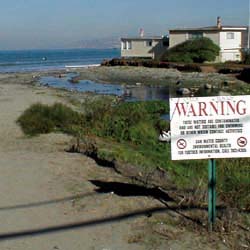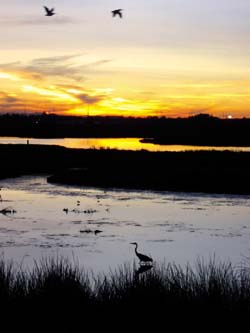What Are TMDLs?
TMDLs: Taking Action for Clean Water| Clean water is essential for fishing, swimming, drinking, agriculture, protecting wildlife habitat, and other beneficial uses. Since 1972, when Congress passed the federal Clean Water Act, the San Francisco Bay Regional Water Quality Control Board has made great strides toward restoring polluted water bodies. Yet, a number of water bodies still do not meet standards established to protect beneficial uses. As part of the effort to solve these remaining water quality problems, the San Francisco Bay Regional Water Quality Control Board is developing Total Maximum Daily Loads (TMDLs). | |
| What Are TMDLs? Total Maximum Daily Loads (TMDLs) are actions to restore clean water. Section 303(d) of the federal Clean Water Act requires that states identify water bodies that do not meet water quality standards. TMDLs examine these water quality problems, identify sources of pollutants, and specify actions that create solutions. TMDLs define how much of a pollutant a water body can tolerate and meet water quality standards. TMDLs account for all the sources of a pollutant, including discharges from wastewater treatment facilities; runoff from homes, agriculture, and streets or highways; "toxic hot spots;" and deposits from the air. In addition to accounting for past and current activities, TMDLs may consider projected growth that could increase pollutant levels.The San Francisco Bay Regional Water Quality Control Board (Regional Board) is developing more than 30 TMDL projects to address more than 160 listings for water bodies impaired by specific pollutants. For example, the TMDL project for diazinon and pesticide-related toxicity in San Francisco Bay Area urban creeks addresses more than 30 impaired urban creeks. |
 A "Don't Swim" warning sign highlights the need to develop TMDLs as part of the effort to solve water quality problems. Photo by: Steve Moore |
| How Are TMDLs Developed? Developing a TMDL involves the following steps: Creating a Project Plan. A project plan describes the water body (or water bodies), pollutant(s), relevant water quality standard(s), and affected beneficial uses; the scope of the TMDL project; the Regional Board's approach; and issues unique to that TMDL. The project plan sets a completion schedule for each step of the process. Developing a TMDL Project Report and an Implementation Plan. A TMDL Project Report describes the water quality problem addressed by the TMDL, details the sources, and outlines solutions. The report includes all the elements necessary for a TMDL (see TMDL Elements). An Implementation Plan describes how and when pollution prevention, control, or restoration actions will be accomplished and who is responsible for these actions. Amending the Basin Plan. The final step in the TMDL process is adopting an amendment to the Water Quality Control Plan for the San Francisco Bay Basin, referred to as the Basin Plan. The Basin Plan amendment is the document that legally establishes a TMDL and specifies regulatory requirements. Basin Plan amendments are adopted through a public process that requires approval by the Regional Board, the State Water Resources Control Board, the California Office of Administrative Law, and the U.S. Environmental Protection Agency. The TMDL process involves working with agencies such as the California Department of Fish and Game, the California Department of Pesticide Regulation, the U.S. Geological Survey, and the National Resource Conservation Service. The process requires coordinating with other programs within the Regional Board, such as the National Pollutant Discharge Elimination System wastewater and storm water programs, and the nonpoint source program. How Are TMDLs Carried Out? |
 Cassandra Roberts of Moss Landing Marine Laboratories holds up a leopard shark caught during a Coastal Fish Contaminations study. High levels of mercury in fish prompted several TMDL projects. Photo by Dyan Whyte  Dyan Whyte of the Regional Board extracts ghost shrimp to test for mercury impacts from on abandoned mine.Photo by Priya Ganguli |
| How Can I Get Involved? Public participation is a vital part of the TMDL process. Those interested in TMDLs are often referred to as stakeholders. Each TMDL has its own stakeholder process, which can include attending meetings, submitting written comments on draft reports, and reviewing posted items on the Regional Board web site. Sometimes, the Regional Board will seek public assistance with tasks, such as data gathering, data analysis, or public education efforts. Reducing Water Pollution One of the most important ways we can help with TMDLs is by taking steps to prevent or reduce water pollution. Everyday activities, such as gardening and driving your car, can lead to water pollution. Reducing pesticide use and taking public transportation are just two of the many ways to reduce water pollution. This website provides more information on things you can do. If you would like to get participate or for more information contact Setenay Frucht at 510-622-2388. |
 Birds fly over the Palo Alto baylands at sunset. TMDLs help ensure clean water for wildlife habitat, fishing, swimming, and many other beneficial uses. Photo by: Don Weden |
|
TMDL Elements |



